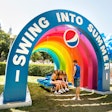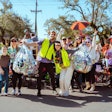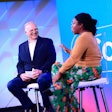
Karen Crawford is a group vice president at Grazzi Exhibitions LLC, the company producing Pathways to Beauty and Well-Being, a consumer exhibition for women founded by Suzanne Grayson. The show will run September 10 to 12 at the Javits Center for an expected 60,000 attendees. Crawford, a former marketing director at Home and American Homestyle magazines, has produced a wide range of major national conventions and trade shows including Spacifically 2000, the Urban Spa Summit in New York, and the Private Label Summit in Washington, D.C.
What is the hardest part of launching this show?
It's not that different from launching a trade show. The only big difficulty was educating the press and exhibitor companies as to what Pathways is. Because it's a consumer-driven show, companies had more questions and we spent more time than we would with a trade show describing and explaining its concept. Once they understood, they were eager to participate, having never before been able to have one-on-one dialogue with their consumers—this personal feedback is absent in retail marketing. Our next struggle is to give companies the publicity that we're committed to.
Has it been a challenge to promote the new event to both consumers and exhibitors?
Of course, but it's something we are excited about. We have promotional cards for salons, subway ads, advertorial pages in our sponsoring magazines, and a bunch of radio and TV spots. All of this reaches a wider, national demographic. And it's not just the vendors and the sponsors that are involved; other companies that aren't part of the show promote Pathways too. For instance, AAA members can use their AAA card to receive free admission and a discount off seminar and exhibit fees.
The target market for the show runs a wide gamut of ages—from teenagers to older women. How did you market the show to everyone?
All our sponsors and exhibitors are a major part of the marketing campaign. For instance Teen People is an exhibitor and advertises the show in its magazine—it brings in the younger girls—and New York University School of Continuing and Professional Studies is sponsoring and aiding attendance by promoting student-body traffic to the exhibition. Self, Allure, and Fitness magazines, Avon, and Pfizer Women's Health/Depo-Provera will bring in an older segment of the market. At the same time the promotions that we are offering such as the mother-daughter and group discounts—targeting Girl Scout troops, sororities, sports leagues, and groups of friends—should reach women of all backgrounds wanting to be self-sufficient and looking out for their well-being.
How would you define a successful exhibition?
Successful show producers will deliver what they say they will. You cannot draw consumers, exhibitors, and sponsors to a show and then fail to fulfill those expectations. While we're flexible and expectations have changed, we're also realistic. You cannot confirm a celebrity appearance for example if you are not 100 percent sure they will be there as scheduled. Success also depends on getting good attendance and our original research found the numbers for our target group to be in the neighborhood of 10.1 million, so our estimated 60,000 consumers is entirely possible, achievable, probable, and acceptable.
The show falls on the weekend of September 11. Do you expect to face any problems regarding security?
No, Javits and the GES security will have no extraordinary levels of security during the expo, but the usual precautions will be taken with exhibitor booths. Pathways didn't choose the date for any specific symbolic reason. But we did get charities involved, specifically the greater New York City affiliate of the Susan G. Komen Breast Cancer Foundation and Dress for Success, because we wanted to do something good for women and good for the community. And women know by coming to Pathways they'll be engaging in an altruistic act for other women as well as having fun.
Do you see any trend shifts in event style and show production?
Experiential marketing is a valuable and increasingly popular tool in approaching consumers—allowing them to feel, taste, touch, and experience and product or service. Using integrated marketing is also a trend, offering exhibitors a chance to integrate their brands into the show. A good example is Sephora, which will give live makeovers using the brands sold in their its stores. This is not just a presentation of products but a chance for consumers to see how products sold at Sephora can be used to their benefit.
—Anna Sekula
Posted 09.08.04
What is the hardest part of launching this show?
It's not that different from launching a trade show. The only big difficulty was educating the press and exhibitor companies as to what Pathways is. Because it's a consumer-driven show, companies had more questions and we spent more time than we would with a trade show describing and explaining its concept. Once they understood, they were eager to participate, having never before been able to have one-on-one dialogue with their consumers—this personal feedback is absent in retail marketing. Our next struggle is to give companies the publicity that we're committed to.
Has it been a challenge to promote the new event to both consumers and exhibitors?
Of course, but it's something we are excited about. We have promotional cards for salons, subway ads, advertorial pages in our sponsoring magazines, and a bunch of radio and TV spots. All of this reaches a wider, national demographic. And it's not just the vendors and the sponsors that are involved; other companies that aren't part of the show promote Pathways too. For instance, AAA members can use their AAA card to receive free admission and a discount off seminar and exhibit fees.
The target market for the show runs a wide gamut of ages—from teenagers to older women. How did you market the show to everyone?
All our sponsors and exhibitors are a major part of the marketing campaign. For instance Teen People is an exhibitor and advertises the show in its magazine—it brings in the younger girls—and New York University School of Continuing and Professional Studies is sponsoring and aiding attendance by promoting student-body traffic to the exhibition. Self, Allure, and Fitness magazines, Avon, and Pfizer Women's Health/Depo-Provera will bring in an older segment of the market. At the same time the promotions that we are offering such as the mother-daughter and group discounts—targeting Girl Scout troops, sororities, sports leagues, and groups of friends—should reach women of all backgrounds wanting to be self-sufficient and looking out for their well-being.
How would you define a successful exhibition?
Successful show producers will deliver what they say they will. You cannot draw consumers, exhibitors, and sponsors to a show and then fail to fulfill those expectations. While we're flexible and expectations have changed, we're also realistic. You cannot confirm a celebrity appearance for example if you are not 100 percent sure they will be there as scheduled. Success also depends on getting good attendance and our original research found the numbers for our target group to be in the neighborhood of 10.1 million, so our estimated 60,000 consumers is entirely possible, achievable, probable, and acceptable.
The show falls on the weekend of September 11. Do you expect to face any problems regarding security?
No, Javits and the GES security will have no extraordinary levels of security during the expo, but the usual precautions will be taken with exhibitor booths. Pathways didn't choose the date for any specific symbolic reason. But we did get charities involved, specifically the greater New York City affiliate of the Susan G. Komen Breast Cancer Foundation and Dress for Success, because we wanted to do something good for women and good for the community. And women know by coming to Pathways they'll be engaging in an altruistic act for other women as well as having fun.
Do you see any trend shifts in event style and show production?
Experiential marketing is a valuable and increasingly popular tool in approaching consumers—allowing them to feel, taste, touch, and experience and product or service. Using integrated marketing is also a trend, offering exhibitors a chance to integrate their brands into the show. A good example is Sephora, which will give live makeovers using the brands sold in their its stores. This is not just a presentation of products but a chance for consumers to see how products sold at Sephora can be used to their benefit.
—Anna Sekula
Posted 09.08.04



















